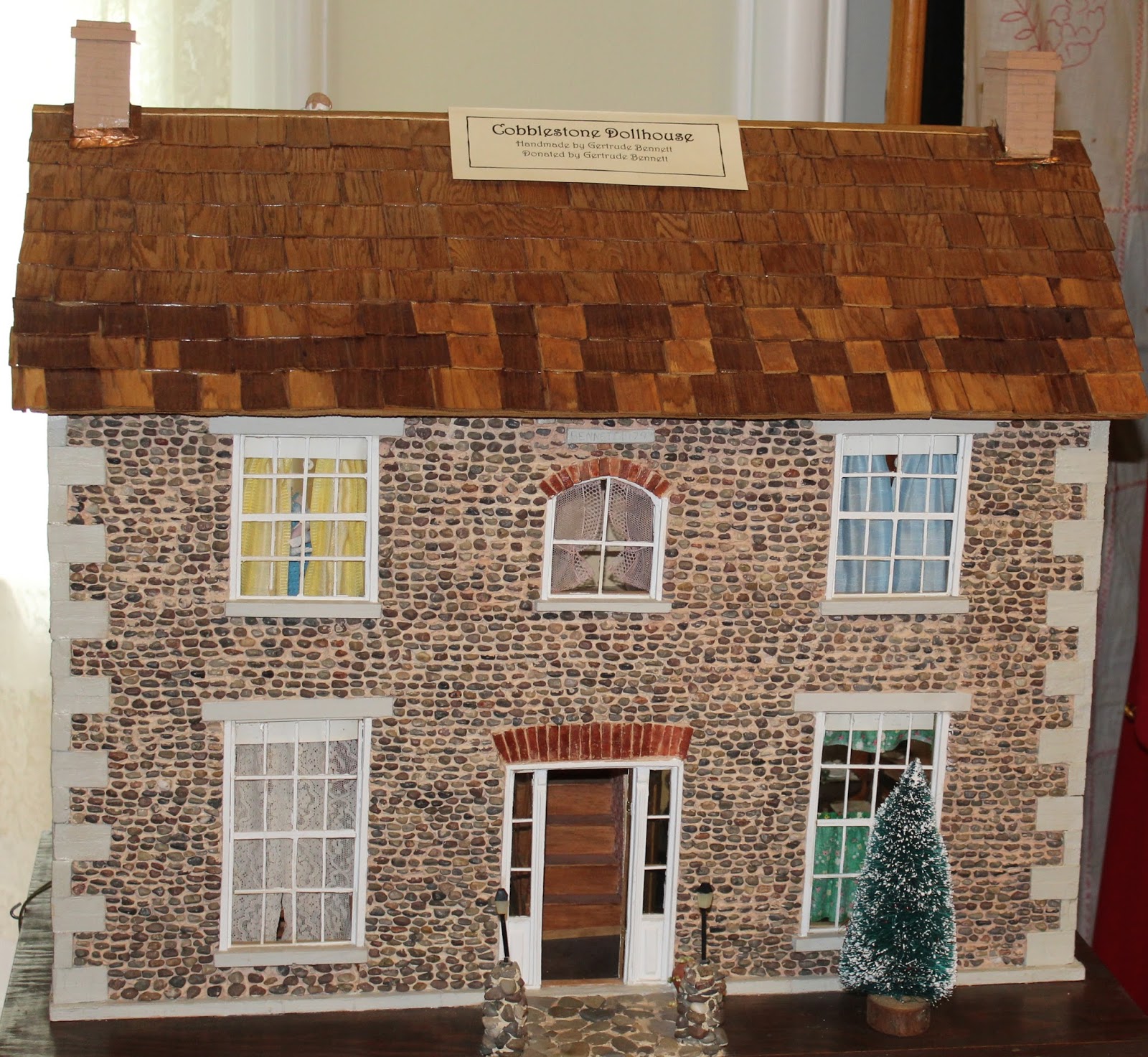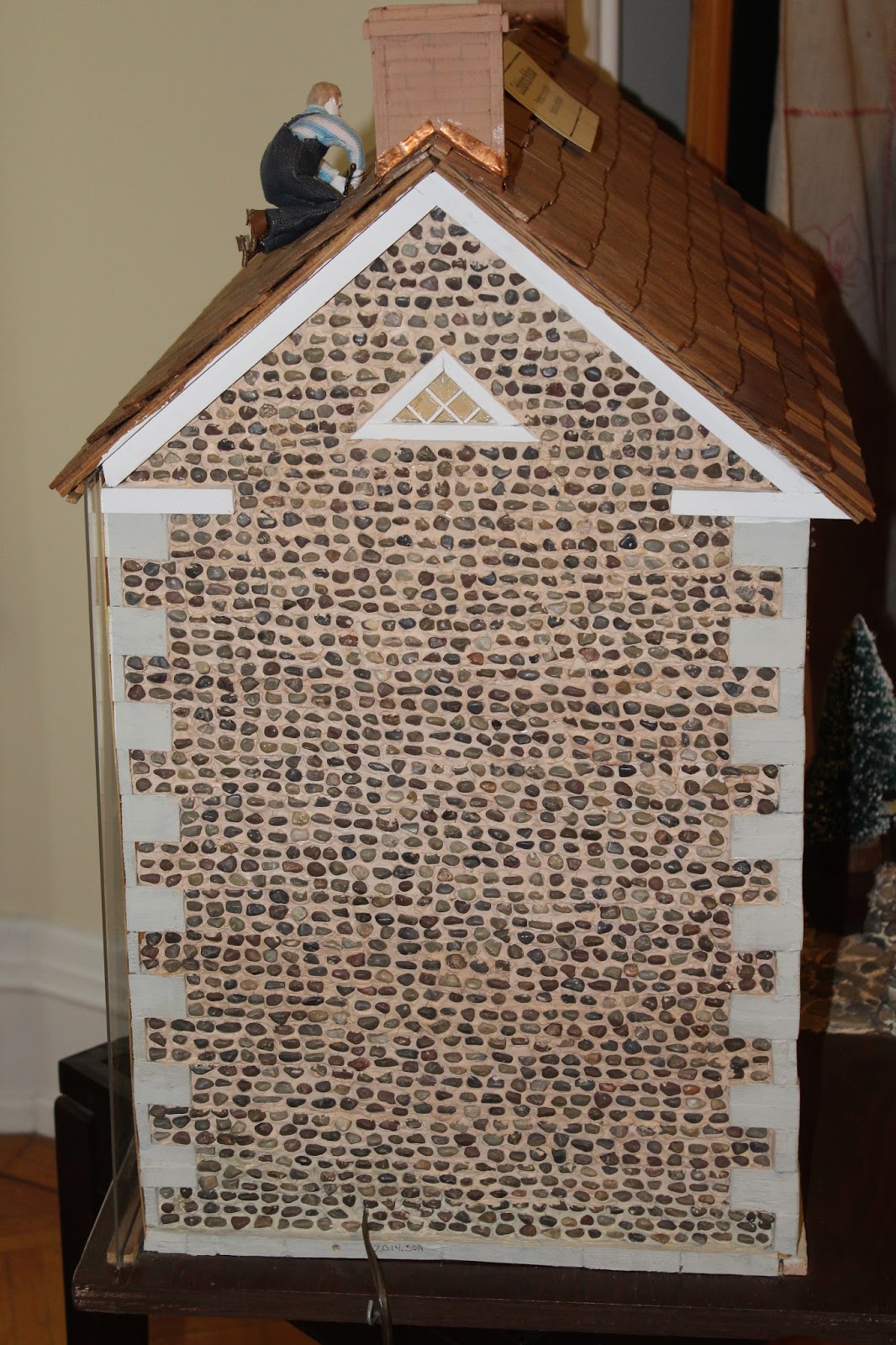

PHELPS - Gertrude Bennett views things a little differently - she sees lamp shades in ping-pong balls, drinking glasses in clear, plastic soda straws and spoons in aluminum foil. For the past eight years, Mrs. Bennett, of Bostwick Road, has focused her creativity on miniature dolls, dollhouses and accessories.
Although she's made miniatures since she was a child it wasn't until 1974 that she built her first dollhouse. Like most dollhouses, it was wooden. Mrs. Bennett wallpapered, painted and decorated the house. She knitted rugs for the floors,
sewed curtains for the windows, hung pictures on the walls, snipped lace doilies, used self-hardening clay to mold figures to people her house and made lamps and chandeliers to light the interior.
That was only the beginning. Mrs. Bennett decided to build a second house - of cobblestones, in the style of many old homes in the area. The house was on a small scale, but the effort in building it wasn't.


One of Mrs. Bennett's cobblestone dollhouses on display at the historical museum in Phelps.
Mrs. Bennett spent months researching styles and drawing patterns for the half-inch plywood shell. Then on sunny days in the spring and fall, she sat on a gravel bank on her farm and selected the 5,600 stones for the outside of the house. "It took months to pick up the stones," she said. "I worked the way the original cobblestone house builders did, sifting through the stones on my property to find just the right sizes."
Mrs. Bennett sorted the stones with a screen, choosing only those one-half to three-eights of an inch long. She tried to use stones of similar shape and color, too.
Every day, Mrs. Bennett cemented the stones to the outside of the house, mixing mortar of speckling compound and coloring. Working with tweezers, she put the best stones on the front, and the coarser ones on the sides, as did the original builders. She fashioned the quoins or cornerstones, and the lintels over the windows and doorways from blocks of wood, and painted them a soft gray.
For her first cobblestone house, she made red bricks of wood to outline the arched upstairs window and top of the front door. Later, an authority on cobblestone buildings praised the accuracy of her construction. "He said he could tell where I stopped working each day, "just like he could on full-size houses, because of the subtle variations of color in the mortar," Mrs. Bennett said. "I have to admit that was accidental, as it probably was for the original builders."
It takes about six months to complete the exterior of a miniature cobblestone house, she said. The shell weighs about eight pounds. When she's working on a house, Mrs. Bennett said she puts in 10-to-14 hour days.
The first house was followed by two more. One with 8,333 stones was featured in an exhibit last month at Geneva's Prouty-Chew Museum. The dollhouse even had its own furnished dollhouse in an upstairs bedroom.
Each house is different, and Mrs. Bennett said she tried to make each authentic. There are woven rag rugs on the floor, and cast iron stoves in the kitchen. The dining room chairs have rush seats, the beds hand crocheted spreads. One house has an attic with a broken chair, piles of newspapers, a mouse, and even spiderwebs in it. The attic in another has cartons of Christmas decorations.
The figures are detailed, too. In one living room, a housewife is knitting with common-pin needles. At another home, a woman is holding a rolling pin, baking cookies.
As one of 13 children, Mrs. Bennett grew up learning to make and create. Her father, a taxidermist and cabinet maker, encouraged his children to work with their hands, and she remembers spending many hours as a young girl making toys and dolls. Others began to recognize her talents early. A doll she made for a seventh grade project earned her an "A plus plus" she recalls proudly.
Her home, which she and her husband designed, is furnished with examples of her handiwork. There are dried flower arrangements inside glass bell jars, and delicate beaded flowers in vases. The flowers' minute detail reflects the knowledge she gained while studying flower arrangement at Cornell University, and working for several years as a designer of wedding floral displays.
She began creating dollhouses gradually, she said. She dressed dolls for he children for many years, then began to create one-room displays of miniature furnishes and too make furniture and accessories for sale at craft shows in the area. Some piece are assembled from kits, some are created entirely by hand.
For Christmas 1974, her son gave her a wooden dollhouse, and Mrs. Bennett was hooked on a new hobby. She made a dollhouse for three of her four granddaughters, she said. Some dollhouses are on display in her family room, where her grandchildren and other young visitors rush when the come over.
In addition to the cobblestone and wooden homes of the early 1800s, Mrs. Bennett has two miniature log cabins in the style of 1769 on display. They are arranged in scenes with the barns and outdoor cooking fires of that time, and are on platforms which make it easier for Mrs. Bennett to bring them to the local schools for pioneer days.
In one scene, a coonskin-capped pioneer is working with a froe, an authentic shingle-making tool; another holds an awl, or drill, the latchstring is out on the cabin door, and the cabin's logs are held together with mud daub. The ax, the notched stick which suspends the black kettle over the cook fire, the hollowed log buckets and carved wooden plates and cubs are authentic and made in the standard one-inch equals one-foot scale of miniatures.
Before she built the log cabins, Mrs. Bennett said, she read "Frontier Living" by Edwin Tunis, which described the tools and homes of the period.
Now that she's conquered the challenge of cobblestone dollhouse building, what does she have in mind for her next project?
Well, Mrs. Bennett said she's always wanted to do "The Old Woman Who Lived in a Shoe," using one of her husband's size 12s for the house. And she's looking for a hollow tree trunk to use for a mouse house.